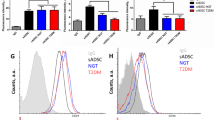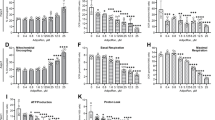Abstract
Objective:
Adiponectin is an adipokine produced by adipose tissue. The present studies examined the in vitro release of adiponectin by human omental adipose tissue explants as well as the mRNA content of freshly isolated non-fat cells and adipocytes plus cultured preadipocytes and adipocytes derived from omental fat.
Results:
The release of adiponectin was reduced while that of interleukin-8 (IL-8) was enhanced in tissue explants from morbidly obese women. The release of adiponectin was also reduced by one-third in explants from morbidly obese diabetic women while that of IL-8 was unaffected by diabetes. The release of adiponectin was enhanced by insulin and by inhibition of endogenous tumor necrosis factor (TNFα) using etancercept. Adiponectin was released in appreciable amounts by the undigested matrix obtained by collagenase digestion of adipose tissue. The release of adiponectin by non-fat cells (matrix+SV cells) was comparable to that by the adipocytes derived from the same amount of tissue while the adiponectin mRNA content of the pooled matrix and SV cell fractions was 40% of that in intact tissue. The adiponectin mRNA content was 48-fold greater in isolated adipocytes than in non-fat cells derived from adipose tissue. In contrast, the amount of adiponectin mRNA in vitro differentiated omental adipocytes was 1 × l06-fold greater than that in cultured preadipocytes while that of leptin was 3 × 104-fold greater.
Conclusion:
Adiponectin mRNA is present in the non-fat cells of freshly isolated adipose tissue and release by the non-fat cells derived from a gram of adipose tissue is comparable to that by adipocytes isolated from the same amount of tissue. While leptin is only released by mature adipocytes, adiponectin is released by both the non-fat cells and the fat cells derived from human omental adipose tissue.
This is a preview of subscription content, access via your institution
Access options
Subscribe to this journal
Receive 12 print issues and online access
$259.00 per year
only $21.58 per issue
Buy this article
- Purchase on Springer Link
- Instant access to full article PDF
Prices may be subject to local taxes which are calculated during checkout




Similar content being viewed by others
References
Scherer PE, Williams S, Fogliano M, Baldini G, Lodish HF . A novel serum protein similar to C1q, produced exclusively in adipocytes. J Biol Chem 1995; 270: 26746–26749.
Hu E, Liang P, Spiegelman BM . AdipoQ is a novel adipose-specific gene dysregulated in obesity. J Biol Chem 1996; 271: 10697–10703.
Maeda K, Okubo K, Shimomura I, Funahashi T, Matsuzawa Y, Matsubara K . cDNA cloning and expression of a novel adipose specific collagen-like factor, apM1 (adipose most abundant gene transcript 1). Biochem Biophys Res Commun 1996; 221: 286–289.
Arita Y, Kihara S, Ouchi N, Takahashi M, Maeda K, Miyagawa J-I et al. Paradoxical decrease of adipose-specific protein, adiponectin, in obesity. Biochem Biophys Res Commun 1999; 257: 79–83.
Hotta K, Funahashi T, Arita Y, Takahashi M, Matsuda M, Okamoto Y et al. Plasma concentrations of a novel, adipose-specific protein, adiponectin, in type 2 diabetic patients. Arterioscler Thromb Vasc Biol 2000; 20: 1595–1599.
Weyer C, Funahashi T, Tanaka S, Hotta K, Matsuzawa Y, Pratley RE et al. Hypoadiponectinemia in obesity and type 2 diabetes: close association with insulin resistance and hyperinsulinemia. J Clin Endocrinol Metab 2001; 86: 1930–1935.
Trujillo ME, Scherer PE . Adiponectin—journey from an adipocyte secretory protein to biomarker of the metabolic syndrome. J Int Med 2005; 257: 167–175.
Kadowaki T, Yamauchi T, Kubota N, Hara K, Ueki K, Tobe K . Adiponectin and adiponectin receptors in insulin resistance, diabetes, and the metabolic syndrome. J Clin Inves 2006; 116: 1784–1792.
Shinoda Y, Yamaguchi M, Ogata N, Akune T, Kubota N, Yamauchi T et al. Regulation of bone formation by adiponectin through autocrine/paracrine and endocrine pathways. J Cell Biochem 2006; 99: 196–208.
Berner HS, Lyngstadaas SP, Spahr A, Monjo M, Thommesen L, Drevon CA et al. Adiponectin and its receptors are expressed in bone-forming cells. Bone 2004; 35: 842–849.
Pineiro R, Iglesias MJ, Gallego R, Raghay K, Eiras S, Rubio J et al. Adiponectin is synthesized and secreted by human and murine cardiomyocytes. FEBS Lett 2005; 579: 5163–5169.
Delaigle AM, Jonas J-C, Bauche IB, Cornu O, Brichard SM . Induction of adiponectin in skeletal muscle by inflammatory cytokines: in vivo and in vitro studies. Endocrinology 2004; 145: 5589–5597.
Lappas M, Yee K, Permezel M, Rice GE . Release and regulation of leptin, resistin and adiponectin from human placenta, fetal membranes, and maternal adipose tissue and skeletal muscle from normal and gestational diabetes mellitus-complicated pregnancies. J Endocrinol 2005; 186: 457–465.
Kaser S, Moschen A, Cayon A, Kaser A, Crespo J, Pons-Romero F et al. Adiponectin and its receptors in non-alcoholic steatohepatitis. Gut 2005; 54: 117–121.
Chen J, Tan B, Karteris E, Zervou S, Digby J, Hillhouse EW et al. Secretion of adiponectin by human placenta: differential modulation of adiponectin and its receptors by cytokines. Diabetologia 2006; 49: 1292–1302.
Corbetta S, Fulfamante G, Cortelazzi D, Barresi V, Cetin I, Mantovani G et al. Adiponectin expression in fetal tissues during mid- and late gestation. J Clin Endocrinol Metab 2005; 90: 2397–2402.
Montague CT, O'Rahilly S . The perils of portliness: causes and consequences of visceral adiposity. Diabetes 2000; 49: 883–888.
Lebovitz HE, Banerji MA . Point: visceral adiposity is causally related to insulin resistance. Diabetes Care 2005; 28: 2322–2325.
Fain JN, Madan AK, Hiler ML, Cheema P, Bahouth SW . Comparison of the release of adipokines by adipose tissue, adipose tissue matrix and adipocytes from visceral and subcutaneous abdominal adipose tissues of obese humans. Endocrinology 2004; 145: 2273–2282.
Yang W-S, Chen M-H, Lee W-J, Lee K-C, Chao C-L, Huang K-C et al. Adiponectin mRNA levels in the abdominal adipose depots of nondiabetic women. Intl J Obes 2003; 27: 896–900.
Hernandez-Morante JJ, Milagro F, Gabaldon JA, Martinez JA, Zamora S, Garaulet M . Effect of DHEA-sulfate on adiponectin gene expression in adipose tissue from different fat depots in morbidly obese humans. Eur J Endocrinol 2006; 144: 593–600.
Lihn AS, Bruun JM, He G, Pedersen SB, Jensen PF, Richelsen B . Lower expression of adiponectin mRNA in visceral adipose tissue in lean and obese subjects. Mol Cell Endocrinol 2004; 219: 9–15.
Motoshima H, Wu X, Sinha MK, Hardy VE, Rosato EL, Barbot DJ et al. Differential regulation of adiponectin secretion from cultured human omental and subcutaneous adipocytes: effects of insulin and rosiglitazone. J Clin Endocrinol Metab 2002; 87: 5662–5667.
Fain JN, Kanu A, Bahouth SW, Cowan Jr GSM, Hiler ML, Leffler CW . Comparison of PGE2, prostacyclin and leptin release by human adipocytes versus explants of adipose tissue in primary culture. Prostaglandins Leukot Essent Fatty Acids 2002; 67: 467–473.
Halvorsen YD, Bond A, Sen A, Franklin DM, Lea-Currie YR, Sujkowski D et al. Thiazolidinediones and glucocorticoids synergistically induce differentiation of human adipose tissue stromal cells: biochemical, cellular, and molecular analysis. Metabolism 2001; 50: 407–413.
Sen A, Lea-Currie YR, Sujkowski D, Franklin DM, Wilkison WO, Halvorsen YD et al. Adipogenic potential of human adipose derived stromal cells from multiple donors is heterogeneous. J Cell Biochem 2001; 81: 312–319.
Chomczynski P, Sacchi N . Single-step method of RNA isolation by acid guanidinium thiocyanate–phenol–chloroform extraction. Anal Biochem 1987; 62: 156–159.
Fain JN . Release of interleukins and other inflammatory cytokines by human adipose tissue is enhanced in obesity and primarily due to the nonfat cells. Vitam Horm 2006; 74: 443–477.
Fain JN, Bahouth SW, Madan AK . TNFα release by the non-fat cells of human adipose tissue. Intl J Obes 2004; 28: 616–622.
Kern PA, Di Gregoria GB, Lu T, Rassouli N, Ranganathan G . Adiponectin expression from human adipose tissue: relation to obesity, insulin resistance, and tumor necrosis factor-α expression. Diabetes 2003; 52: 1779–1785.
Bruun JM, Lihn AS, Verdich C, Pedersen SB, Toubro S, Astrup A et al. Regulation of adiponectin by adipose tissue-derived cytokines: in vivo and in vitro investigations in humans. Am J Physiol Endocrinol Metab 2003; 285: E527–E533.
Degawa-Yamauchi M, Moss KA, Bovenkerk JE, Shankar SS, Morrison CL, Lelliott CJ et al. Regulation of adiponectin expression in human adipocytes: effects of adiposity, glucocorticoids, and tumor necrosis factor α. Obes Res 2005; 13: 662–669.
Maeda N, Takahashi M, Funahashi T, Kihara S, Hishizawa H, Kishida K et al. PPARγ ligands increase expression and plasma concentrations of adiponectin, an adipose-derived protein. Diabetes 2001; 50: 2094–2099.
Wang B, Trayhurn P . Acute and prolonged effects of TNF-α on the expression and secretion of inflammation-related adipokines by human adipocytes differentiated in culture. Pflugers Arch 2006; 452: 418–427.
Fain JN, Bahouth SW, Madan AK . Involvement of multiple signaling pathways in the post-bariatric induction of IL-6 and IL-8 mRNA and release in human visceral adipose tissue. Biochem Pharmacol 2005; 69: 1315–1324.
Halleux CM, Takahashi M, Delporte ML, Detry R, Funahashi T, Matsuzawa Y et al. Secretion of adiponectin and regulation of apM1 gene expression in human visceral adipose tissue. Biochem Biophys Res Commun 2001; 288: 1102–1107.
Author information
Authors and Affiliations
Corresponding author
Rights and permissions
About this article
Cite this article
Fain, J., Buehrer, B., Tichansky, D. et al. Regulation of adiponectin release and demonstration of adiponectin mRNA as well as release by the non-fat cells of human omental adipose tissue. Int J Obes 32, 429–435 (2008). https://doi.org/10.1038/sj.ijo.0803745
Received:
Revised:
Accepted:
Published:
Issue Date:
DOI: https://doi.org/10.1038/sj.ijo.0803745
Keywords
This article is cited by
-
Double blind control trial of vitamin D fortified milk on the expression of lncRNAs and adiponectin for patients with metabolic syndrome
Diabetology & Metabolic Syndrome (2023)
-
Regulation of cytokine gene expression by orosomucoid in neonatal swine adipose tissue
Journal of Animal Science and Biotechnology (2016)
-
Serum leptin levels are inversely correlated with omental gene expression of adiponectin and markedly decreased after gastric bypass surgery
Surgical Endoscopy (2012)
-
Effect of the Cannabinoid Receptor-1 antagonist SR141716A on human adipocyte inflammatory profile and differentiation
Journal of Inflammation (2011)
-
The inhibitory effects of PKCθ on adiponectin expression is mediated by ERK in 3T3-L1 adipocytes
Journal of Endocrinological Investigation (2011)



